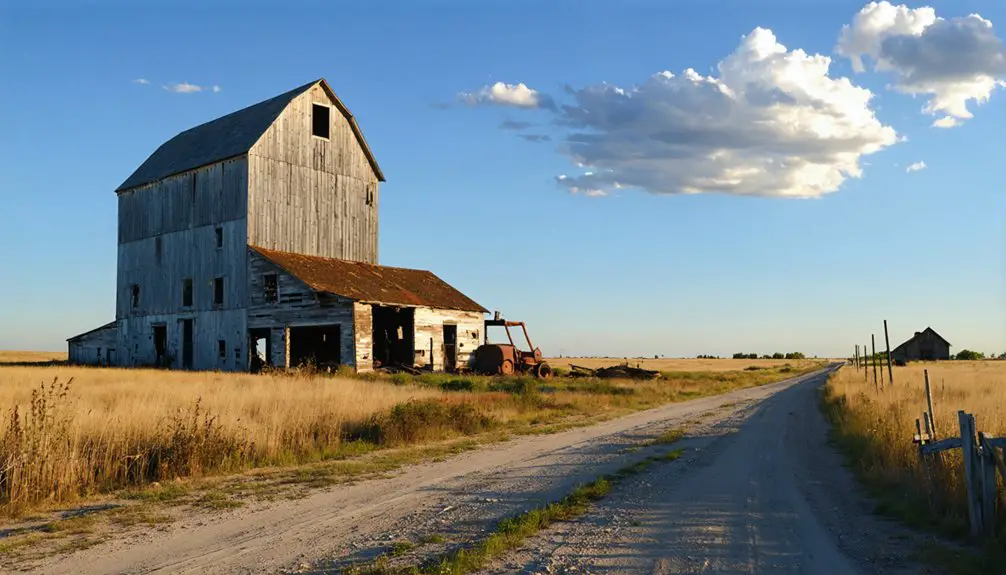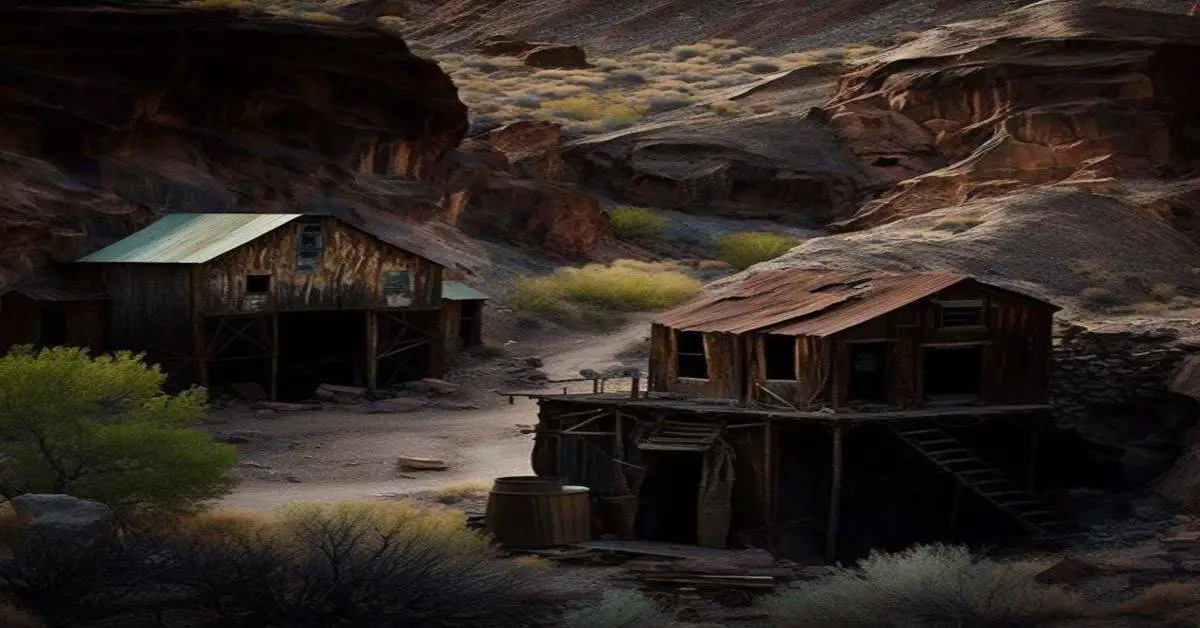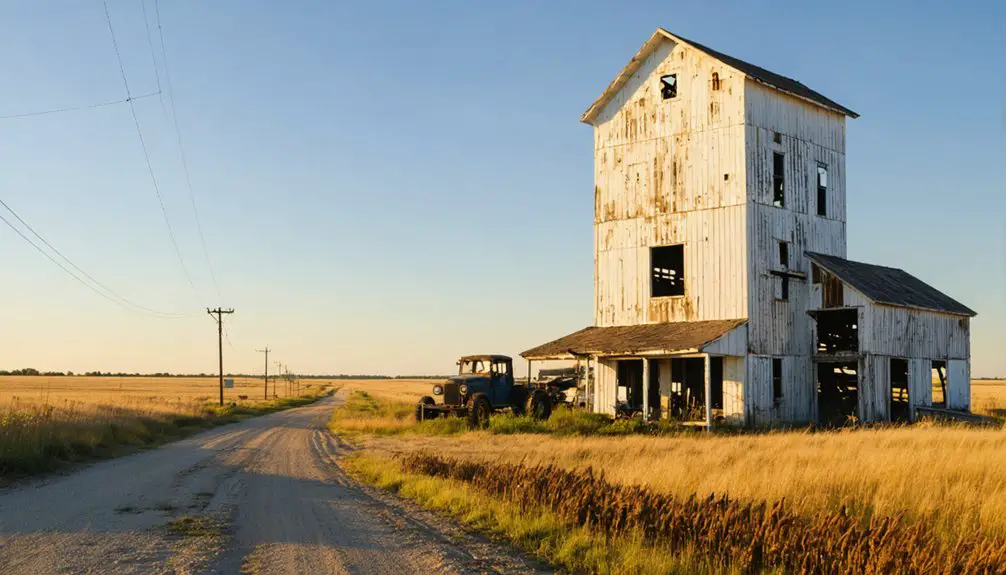You’ll find Arena, North Dakota’s haunting remains along an old Northern Pacific Railroad line, where it flourished from 1906 until the 1930s. The town peaked at 150 residents during the 1920s, supported by German, Jewish, and Mennonite farming communities. Today, you can explore the weathered grain elevators and crumbling St. John’s Lutheran Church that stand as silent sentinels of this ghost town‘s bygone prosperity. Arena’s untold stories echo through its prairie-reclaimed streets.
Key Takeaways
- Founded in 1906 by Patterson Land Company, Arena reached its peak population of 150 residents during the 1920s.
- The Great Depression and Dust Bowl conditions caused severe economic decline, reducing population to 35 residents by 1935.
- Notable structures include St. John’s Lutheran Church and weathered grain elevators, which remain as historical landmarks today.
- Arena’s last major institutions closed with the school in 1961 and post office in 1996.
- The town’s abandoned main street and prairie-covered landscape exemplify North Dakota’s rural decline in the 20th century.
A Town Born From Railroad Dreams
As the Patterson Land Company of Minnesota acquired over a million acres of railroad land between Bismarck and Jamestown, they established Arena in 1906 as part of their ambitious settlement vision.
You’ll find Arena nestled in a natural basin surrounded by hills, a setting that inspired its name and attracted settlers seeking opportunity in North Dakota’s promising landscape.
The railroad impact transformed this quiet prairie into a bustling community when the Northern Pacific Railroad built its Pingree-Wilton line through Arena in 1910.
The arrival of the Pingree-Wilton railway line in 1910 awakened Arena’s prairie, breathing new life into this once-quiet land.
Settlement patterns followed the typical framework of early 1900s railroad towns, with Harry A. Mutchler establishing the post office and working closely with Patterson Land Company to promote growth.
The town’s strategic location along the rail line made it an ideal hub for agricultural commerce and community development. The establishment of St. Johns Lutheran Church became a cornerstone of Arena’s religious and social life. By 1920, the town reached its peak with 150 residents calling Arena home.
Life in Arena’s Golden Years
While many North Dakota towns struggled to gain traction in the early 1900s, Arena flourished into a vibrant community of 150 residents by 1920.
You’d find a diverse mix of German, Jewish, and American farmers working the land, while nearby Mennonite settlers added to the cultural fabric. The town was established when the post office opened 1906. The town’s basin-like setting, surrounded by protective hills, created an ideal spot for community gatherings at the general store and local churches.
Agricultural practices dominated daily life as farmers battled harsh winters and stormy summers to cultivate their crops and tend livestock. By 1930, the population had drastically declined to only 35 residents. The two-story brick schoolhouse stood proudly on the hill, while Selma Rice’s general store served as both post office and social hub.
Life revolved around farming schedules, with the store and churches providing essential connection points for Arena’s hard-working residents.
The Mennonite Settlement Connection
In 1904, a thriving Mennonite community established itself four miles south of Arena, predating the town’s official founding by two years. These settlers, who’d arrived from Marion, South Dakota, brought with them their distinct Mennonite culture and agricultural practices focused on community cooperation and sustainable farming.
You’ll find their influence woven into Arena’s early development, as they contributed greatly to the area’s agricultural growth. When Arena’s wooden schoolhouse became available in 1925, the Mennonite community transformed it into their church, creating a crucial center for both worship and community gatherings.
Even as Arena’s fortunes declined in the 1930s during the Great Depression and Dust Bowl, the Mennonite settlement maintained its presence longer than the town itself, preserving their traditions in central North Dakota’s changing landscape.
From Prosperity to Ghost Town
During its heyday in the 1920s, Arena flourished as a vibrant agricultural hub with nearly 150 residents and a diverse array of businesses.
You’d have found a bustling community with two general stores, multiple creameries, and a prominent two-story brick school perched on a hill. The town’s social life revolved around its local baseball team that brought the community together.
The 1930s brought devastating changes that sparked Arena’s economic decline and community migration:
- The Great Depression crushed local commerce and forced many businesses to close
- Harsh dust bowl conditions destroyed farming operations
- Population plummeted from 150 to just 35 residents by 1935
- The school closed in 1961, with students redirecting to Wing
- The post office’s closure in 1996 marked Arena’s final shift to a ghost town
Today, you’ll find only ruins and weathered structures where this once-thriving town stood, slowly being reclaimed by nature. St. John’s Lutheran Church still stands but risks imminent collapse due to its failed cinderblock foundation.
What Remains Today: Arena’s Legacy
Standing as a haunting symbol of rural decline, Arena’s remaining structures paint a stark picture of its former liveliness.
You’ll find St. John’s Lutheran Church, the town’s most photographed landmark, slowly succumbing to harsh weather conditions. A few weathered grain elevators stand sentinel near the site, their protective siding long gone. The town’s economic struggles led to its population dropping to 35 by 1935.
Time-worn and exposed, St. John’s Lutheran Church stands guard with skeletal grain elevators against the relentless prairie elements.
Today, you can witness how nature reclaims the land, with prairie grass overtaking what was once a bustling main street.
The town’s cultural symbolism lives on through artifacts like 1920s postcards showing thriving businesses and the old train depot.
While most structures are now off-limits behind “no trespassing” signs, Arena’s legacy endures as a powerful reminder of the Great Plains’ challenging history, drawing photographers and historians who seek to document its atmospheric ruins.
Frequently Asked Questions
Were There Any Notable Crimes or Incidents in Arena’s History?
With Arena’s population dropping 77% during the Depression, you won’t find any crime reports. Historical incidents centered on economic hardships, environmental challenges, and community changes like school and post office closures.
What Happened to the Original Residents After They Left Arena?
You’ll find most former Arena residents relocated to nearby towns, while others moved to urban centers. Their relocation stories and family legacies live on through descendants who settled in more economically viable communities.
Did Arena Have Its Own Cemetery, and Does It Still Exist?
Yes, you’ll find St. John’s Cemetery still exists 0.7 miles northeast of Arena on 392nd St. NE. This historic burial location served local residents and remains connected to St. John’s Lutheran Church.
Were There Any Native American Settlements in the Arena Area Before?
While there’s no direct evidence of settlements at Arena’s exact location, you’ll find Native tribes like the Mandan and Hidatsa lived nearby, with historic landmarks at Knife River Villages just 20-30 miles away.
What Natural Disasters, Besides the Dust Bowl, Affected Arena’s Development?
You’ll find severe blizzards isolated the town, while flood impacts damaged essential infrastructure. Droughts created fire hazards and ruined crops, and tornadoes struck periodically, destroying buildings and farms.
References
- https://www.quincyvagell.com/arena/
- https://www.legendsofamerica.com/arena-north-dakota/
- https://ghostsofnorthdakota892857007.wordpress.com/category/arena-nd/
- https://ghostsofnorthdakota892857007.wordpress.com/tag/burleigh-county/
- https://www.youtube.com/watch?v=hRFfy3HQaus
- https://writinforthebrand.com/the-railroad-and-settlement-in-early-north-dakota/
- https://www.history.nd.gov/hp/PDFinfo/North-Dakota-Railroads-MPDF-Final-corrected.pdf
- https://en.wikipedia.org/wiki/Grand_Forks
- https://gameo.org/index.php?title=North_dakota_(usa)
- https://commons.und.edu/cgi/viewcontent.cgi?filename=9&article=1000&context=oers&type=additional



